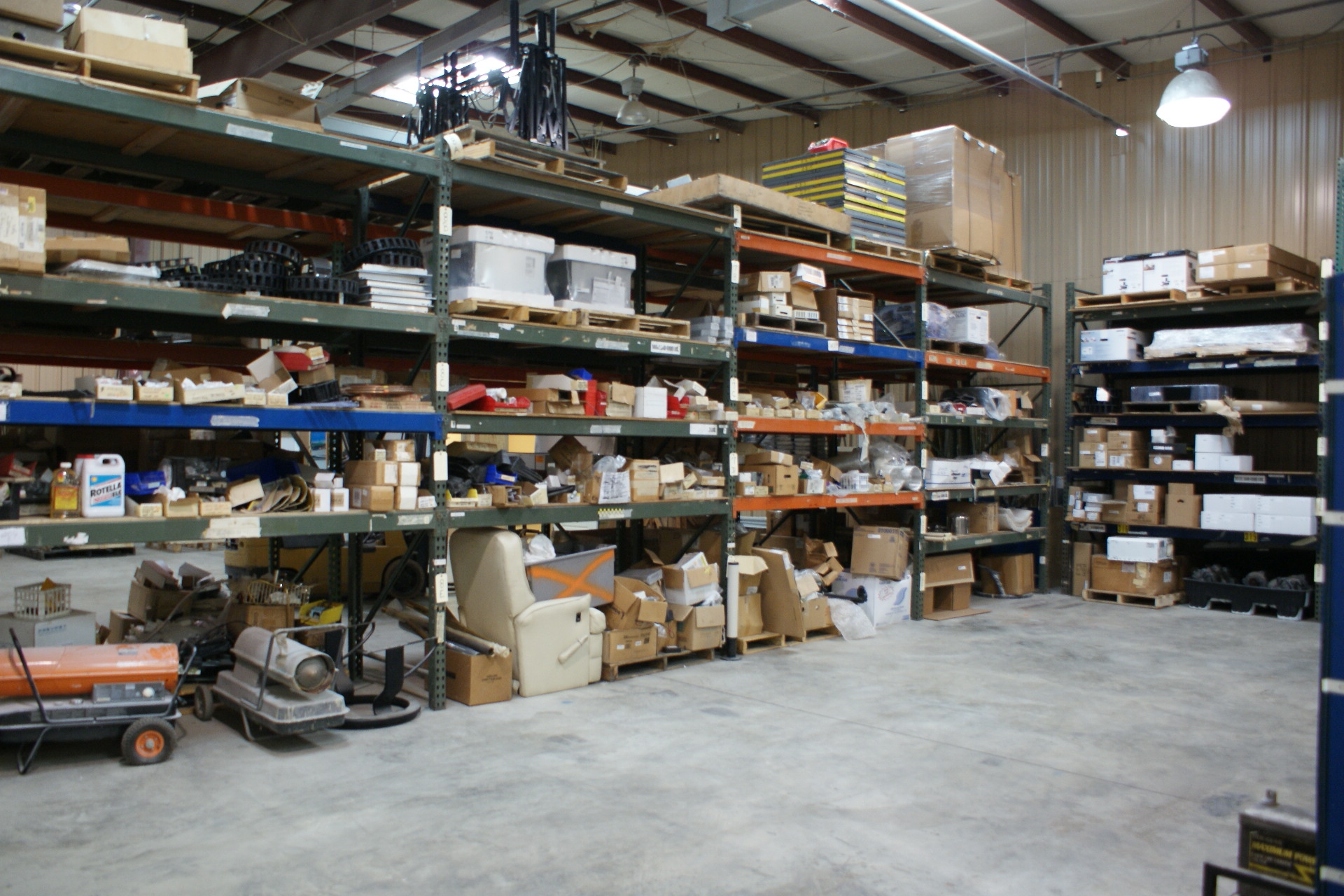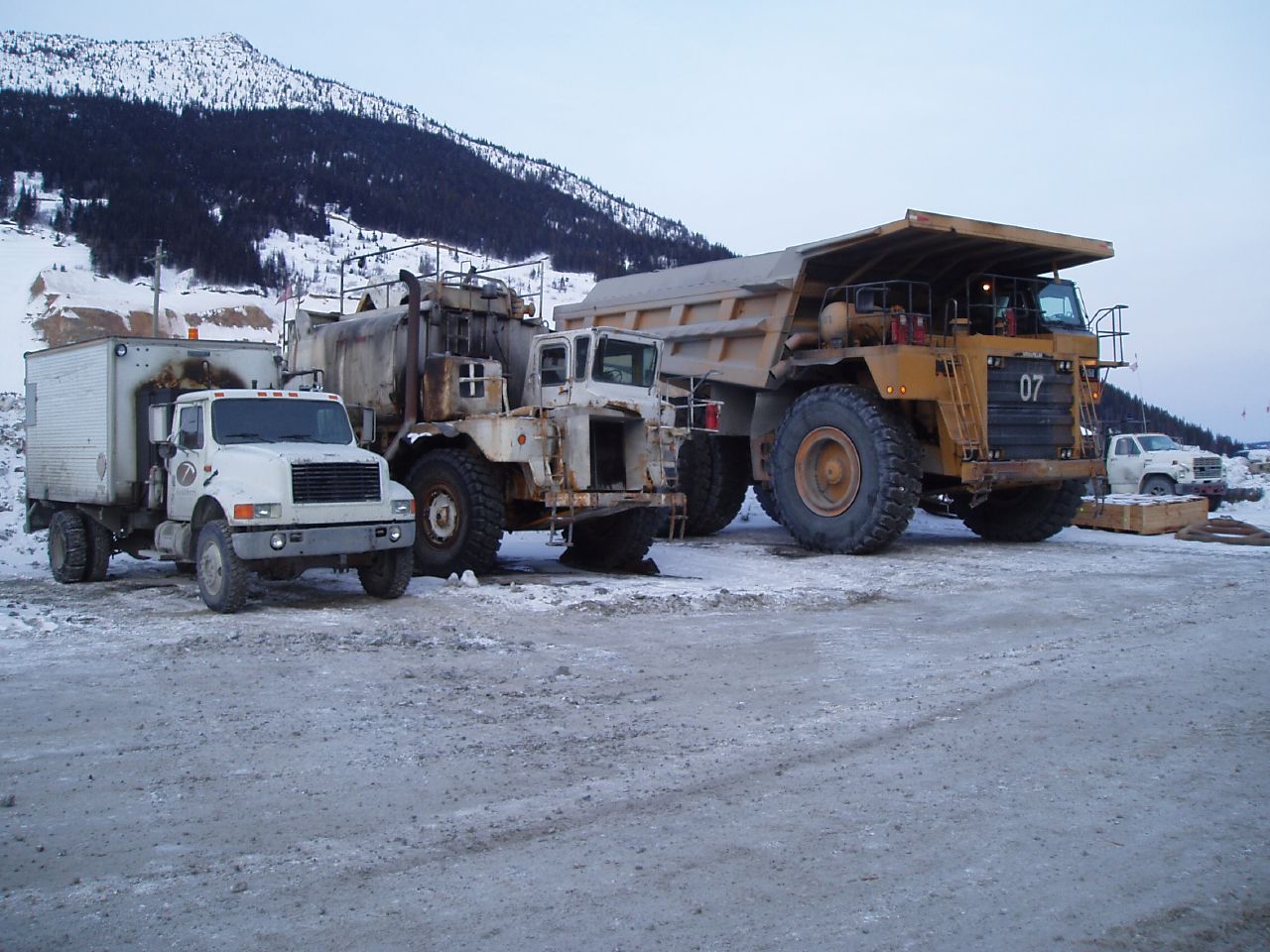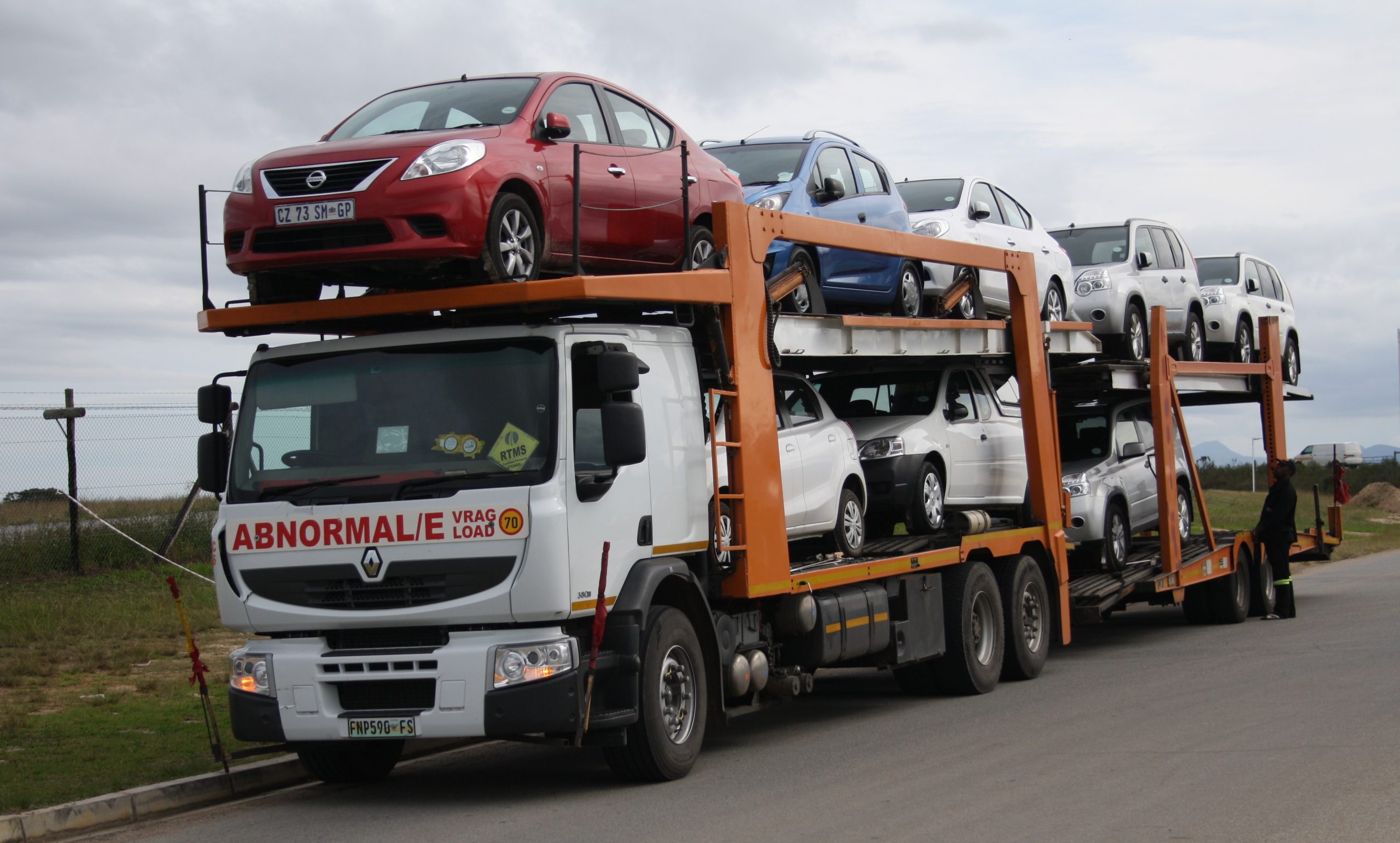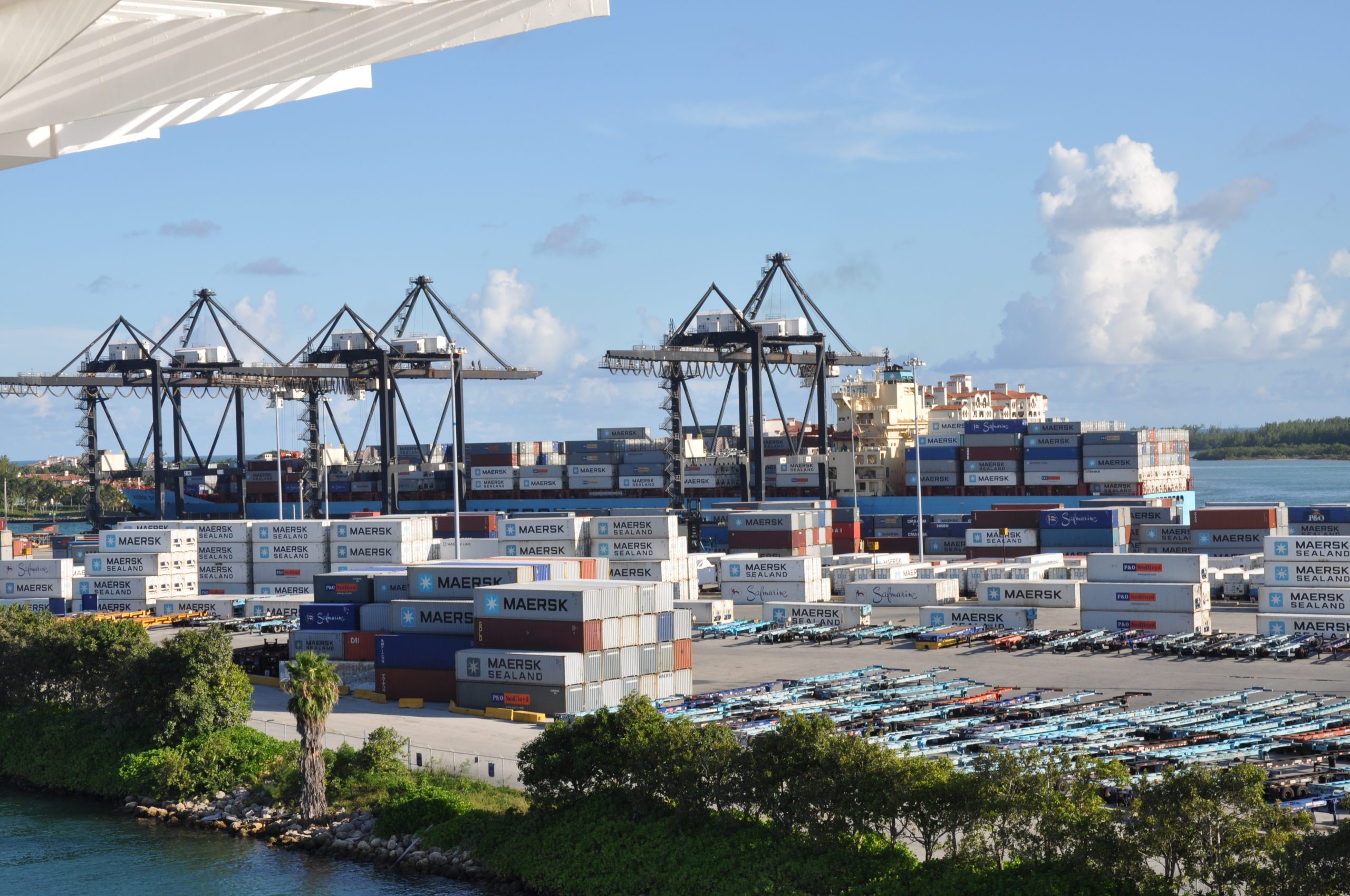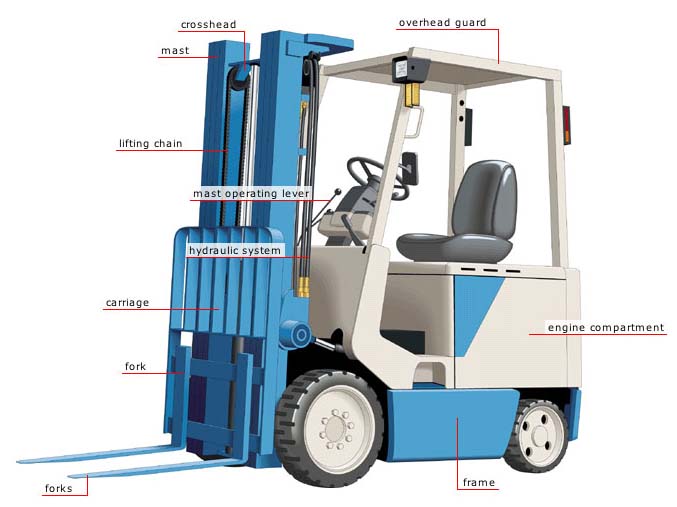Chapter 5 – Warehousing
5.1 Introduction
Raw materials and products are stored in warehouses, buildings, and other types of locations while waiting to be transported. When determining which type of storage facility to use, consideration must be given to the type of material or product. You may remember that in a previous chapter, we discussed the need to temperature control COVID-19 vaccines during transit and storage. Vaccines are not the only products requiring specific conditions to protect them during their movement and storage. In this chapter, we will explore the different types of warehousing available, the role that warehouses and distributions centres play in a supply chain, and review the type of equipment used to load and unload products at warehouses.
5.2 Learning Objectives
- Compare the uses of different types of warehouses.
- Examine the role warehouses and distribution centers play in the supply chain.
- Describe the type of equipment used to load and unload products.
5.3 Pre-Assessment
5.4 Logistics for Warehousing Product
Logistics includes both moving and storing products. Warehouses, buildings, and locations for storage are typically used to hold products that have just been made, are in transit, or are at their destination awaiting a customer order. As depicted in the image below storage (also referred to as warehousing) may take many forms such as raw material storage, finished good storage, in-transit storage, and storage in distribution centres.
The name that a company chooses to call its warehouses may vary. For example, Amazon refers to its warehouses and distribution centers as fulfillment centers (Amazon FC Tours, 2021). A typical warehouse may store various products in boxes, on skids, and on racks. In a warehouse, you will see the use of labels and packaging that identifies one product from another. People and machines such as manually operated forklifts, cranes, or fully automated robots will move products within the warehouse.
A Product Supply Chain

Note. From co-author, 2021. [Image Description]
5.5 Warehouse Processes
In a supply chain planning is done to determine the required amount and type of warehousing and once products are received most general warehouses follow a similar process such as this one:
- Planning is done to determine the amount and type of warehousing required.
- Warehousing space is acquired or reserved.
- The supplier material/product is received at the warehouse from incoming vehicles.
- The material/product is unloaded, documented, stored, and then issued to production.
- The end product completes its manufacturing process and is stored as finished goods inventory (FGI).
- The end product awaits a customer requirement.
- The end product is retrieved, packed, documented, and loaded onto outgoing vehicles.
- The end product is shipped to its next destination, often a type of in-transit warehousing location
Amazon’s Fulfillment Centres use a seven-step warehouse process that is a slightly different process than listed above. Amazon receives products that are ready for consumers. Watch this video and see if you can identify them.
This video link takes you through this process with a virtual tour of an Amazon Fulfillment Center.
Amazon FC Tours. (2021, April 10). Amazon fulfillment center video tour. YouTube. https://youtu.be/UAKPoAn2cB0
Amazon’s Seven-Step Warehouse Process (Amazon FC Tours, 2021): Consider How it Differs or is Similar to General Warehouse Processes
How is Amazon’s seven-step warehouse process similar or different from the general warehouse processes?
- Receive: Receive the product from suppliers.
- Stow: Scan the product, check it for damages, and place it in storage in racks or containers.
- Pick: Retrieve the product from where it is stored. This is the beginning of outbound operations.
- Flow: Monitor the product as it moves through the centre. Ensures deliveries leave on time.
- Pack: Sorted into single and multi-pack, putting the product in appropriate boxes or containers.
- Scan-Label-Apply-Manifest (SLAM): The parcel is identified by the barcode applied at the pack station, and then a label and shipping information is added.
- Ship: Load it onto a truck and ship it out to the customer.
5.6 Warehouses in the Supply Chain – Origin to Destination
Raw materials and products may require the same or different types of warehouses depending on where they are in the supply chain. Where they are in the supply chain can be subjective and depends on the perspective of those involved in the same product supply chain, one organization’s finished product is another organization’s raw material. In Figure 5.1 not all materials or products required the same number of supply chain steps. Warehousing works in the same way, the number of warehouses is determined by the materials or product, their transportation and storage needs, the distribution network used, and cost.
For example, Figure 5.2 shows the different types of warehouses at different points in the supply chain. Inventory at the origin awaiting shipment needs logistics to move it to the manufacturing process and then for its journey to the customer. The product is stored in finished goods storage area, an internal warehouse, or a shipping dock. Many different types of warehouses can be used while products are in transit, depending on the type of product and its transportation and distribution arrangements. At their destination, products end up at receiving docks or receiving areas, where they are processed and placed in the customer’s warehouse or a storage area. Outside storage areas and storage yards might be used throughout the supply chain where the product is suited to this form of storage, as shown in Figure 5.5.
Figure 5.2
Logistics from Suppliers to Customers
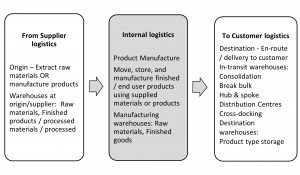
Note. From co-author. [Figure Description]
5.7 Warehouse Types and Their Uses
Warehouses at Raw Material and Product Manufacturing Stages
Warehouses at the raw materials and Product Manufacturing stages refer to the stages where either raw materials are waiting to manufactured or where raw materials have been processed or manufactured into a finished product. That finished product then gets stored in a finished goods warehouse as they wait for transport further down a supply chain. In the case of raw materials, raw materials are piled as they wait for transport into a supply chain. In the case of automobiles, they are stored in outdoor lots outside of their manufacturing plants while they wait to be picked up for transport to car dealerships.
Figure 5.3 shows products on racks and shelves in boxes and pallets that have finished processing and are awaiting shipment.
Figure 5.3
Industrial Hall
Note. From Millennium Luxury Coaches, 2010. CC BY-NC-SA 2.0
Figure 5.4 shows trucks waiting outside ready to load raw material from the raw material pile behind to be shipped to the next step in the supply chain process. In this case, there is no warehouse building.
Figure 5.4
Trucks at a Mine
Note. From Ian BC North, 2006 CC BY-NC 2.0
Figure 5.5 shows an auto manufacturing plant. Outside an automotive manufacturing plant, there are large storage areas (sometimes referred to as lots) of cars awaiting pick up for transport that look similar to this. These cars are awaiting shipment to their next destination in the supply chain, car dealerships.
Figure 5.5
New Cars Being Stored
Note. From Jaxport, 2013. CC BY-NS 2.0.
5.72 Warehouses in the En-route or In-Transit Phase
Storage can take on different forms during the Logistics phase of the supply chain process. You may remember that different materials and different products require different types of warehouses depending on the material, product, transportation and distribution needs. Common warehouses during the in-transit phase of the supply chain include consolidation, cross-docking, break-bulk, hub-and-spoke, or distribution centers. Product in containers or suitably protected might even be left outside in yards or parking lots.
Consolidation Warehouses
Consolidation warehouses store products from different suppliers that are bound for a similar destination. The products are stored while they are consolidated (grouped together) based on destination and then shipped. Consolidation may increase customer satisfaction and reduce stored inventory as it allows for frequent shipments of consolidated products from multiple suppliers to similar destinations instead of waiting until you have enough orders for a full truckload (FTL) from just one supplier (Sunol, 2021). Consolidation often results in larger loads and reduced shipping costs (Cole International, n.d., para. 2).
Cross-Docking Warehouses
Cross-docking involves trucks that arrive at a warehouse and have their goods unloaded, and after being sorted, loaded directly into another truck docked on the opposite side of the facility. There is no actual storage involved in cross-docking. The loading dock is used “as a staging area where incoming shipments are quickly transitioned into outgoing shipments” (Cole International, 2016, para. 6). Figure 5.8 illustrates the layout of a cross-dock. It is a fast way to split the load of one type of product per truck into mixed loads on another truck.
These videos demonstrate cross-docking and the processes involved.
McKibben, K. (2017, February 3). What is cross-docking? [Video]. YouTube. https://youtu.be/N2lnL9uHyNY
DatalogicAccuSort [username]. (2013, February 7). Cross-docking: Receiving dock direct to shipping dock [Video]. YouTube. https://youtu.be/OS5CrureJoE
Cross-Docking Terminal (warehouse)
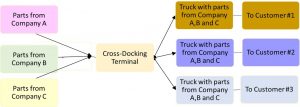
Note: From co-author, 2021. [Image Description]
Break-Bulk Warehouses
In this type of warehouse, large bulk-packed quantities are split into smaller quantities and stored until transportation is required in a supply chain. The products are re-packaged and labelled before being shipped to their destination.
Further Reading: Break-Bulk Warehouses
The APICS Dictionary defines break bulk as “dividing truckloads, railcars or containers of homogeneous items into smaller, more appropriate quantities for use” (as cited in APICS Coach, 2017, para. 3).
Hub-and-Spoke and Point-to-Point Warehouses
Hub-and-spoke warehouses are large and tend to be located at places where transportation systems converge. Think of the shape of a bicycle wheel. Hub-and-spoke systems consolidate products at a spoke (regional) warehouse, move them to a hub (central/national) warehouse, send them back out to a spoke warehouse, then distribute them.
Point-to-Point Warehousing
End-to-point warehousing does not consolidate, nor store but sends products directly to their destination. Airlines tend to use this system for moving people. Passengers are collected at major airports like Chicago, Atlanta, Cincinnati, and Denver. The passengers then transfer to a different plane that files them to their destination.
Further Reading: Point-to-Point Versus Hub-and-Spoke Networks
In a point-to-point system, products move from any warehouse to another warehouse. In a hub-and-spoke system, products move to a central “hub” warehouse before being distributed to the next warehouse in the process. (Rodrigue, 2021).
Distribution Centers
Distribution centers are the last stop before a product is shipped to a wholesaler, retailer or to an end-user. Distribution centers tend to be located close to the market. Amazon calls these facilities “Fulfillment Centers”. They are located close to customers. This allows Amazon to shorten delivery times and support its “Amazon Prime” quick deliveries.
In Figure 5.10, the Distribution Centre/Fulfillment Centre there is typically a high variety of products that are ready to be delivered on short notice. They are located close to the end-use customer so that you can have short delivery times. A lot of inventory moves through these facilities and does not stay there for a long time.
Figure 5.7
Amazon Fulfillment Centre (also known as a Distribution Centre)

Note. From Scottish Government, 2011. :CC BY-NC 2.0
Warehouses at the Destination
If the product’s destination is the manufacturing factory in the supply chain, storage will be required. The incoming materials will need to be stored before moving on to the next step in the manufacturing process.
If the product’s destination is the end-user, storage may not be necessary and the product may be used immediately. Different operational logistics are required to manage that type of inventory which is not covered in this text.
Figure 5.8 shows a factory’s internal storage and warehousing of lumber used to make doors (considered raw materials). This lumber was received through a logistics network that they manage and use to make their products. A finished goods warehouse or storage area would be the origin for the next step in the manufacturing and logistics processes.
Figure 5.8
Factory Internal Storage
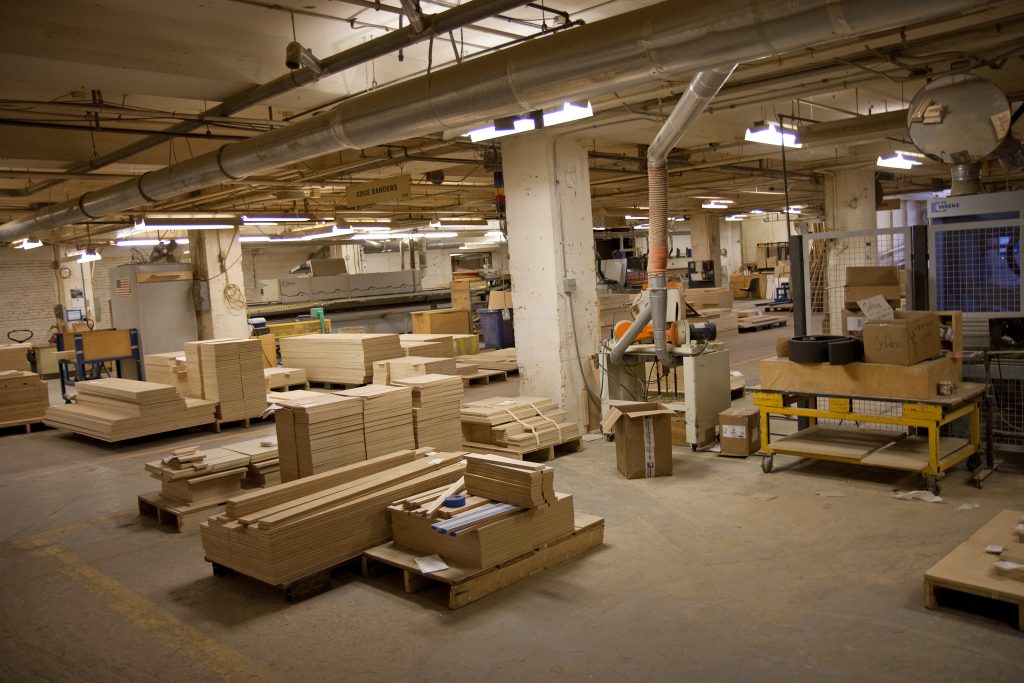 Note. From Lester Public Library, 2012. CC BY-NC-SA 2.0.
Note. From Lester Public Library, 2012. CC BY-NC-SA 2.0.
When vehicles arrive at a car dealership, they are unloaded and moved onto the lot.
Figure 5.9 shows a tractor-trailer that is designed for carrying cars to dealers.
Figure 5.9
Tractor Trailer Carrying Cars to a Dealership
Note. From Adams, 2015. CC BY-SA 2.0.
Their next step is to be received and prepared for sale as shown in this car lot. This image shows cars at a car dealership waiting to be purchased by customers. This storage lot is a destination warehouse.
Figure 5.10
Used Car Dealership
Note. From Lang, 2015. CC BY-SA 4.0.
5.8 Moving Product to Storage
Cranes
Various types of equipment are used to move cargo to storage. At ports, large cranes, as shown in the figures below, are used to unload bulk cargo from ships. Heavy bulky items such as shipping containers, tree logs, and metal fabricated parts may require cranes to move them. There are various types of cranes depending on the crane’s location.
Figure 5.11 shows a large crane with large holding and clamping devices for loading and unloading shipping containers from ships to move to trucks, trains, or storage.
Figure 5.11
Port of Miami, Container Ship Yard
Note. From Kramer, 2009. CC BY 2.0.
Figure 5.12 shows a movable overhead crane with clamping devices designed for shipping containers placing a shipping container onto the bed of a truck. This image shows containers being exchanged, using a movable overhead crane with clamping devices designed for shipping containers, between trains and trucks in an intermodal yard.
Figure 5.12
Talleyrand Terminal Railroad
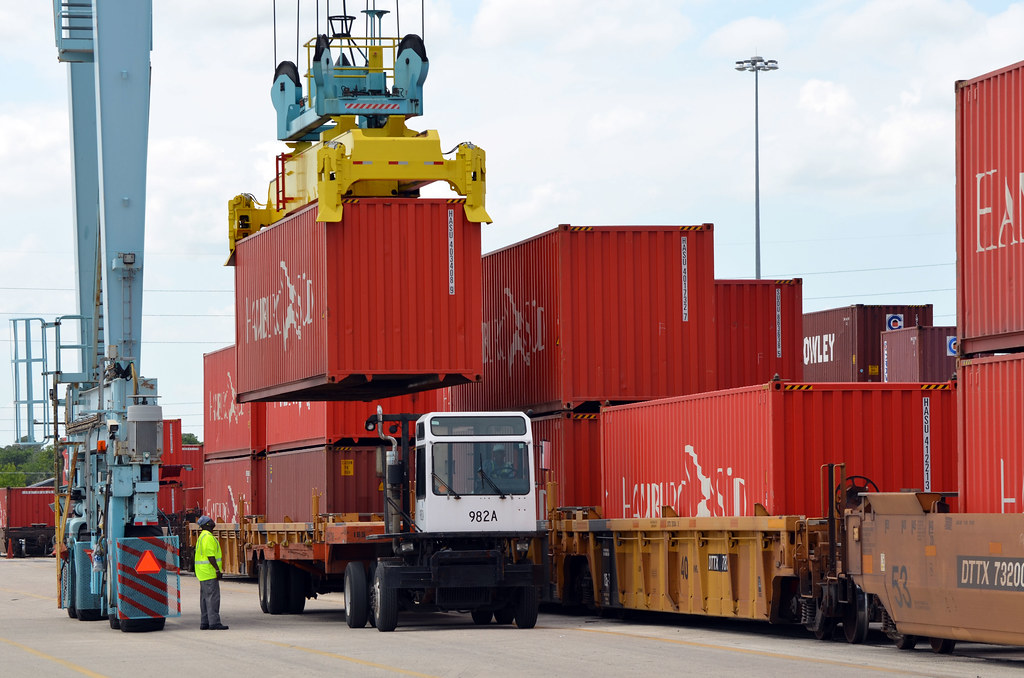
Note. From Jaxport, 2013. CC BY-NC 2.0.
Figure 5.13 shows large logs being moved by a crane at a sawmill onto a flatbed railway car. The jaws of the crane are specifically designed to handle logs and lumber.
Figure 5.13
Crane Loading Large Logs onto Railroad
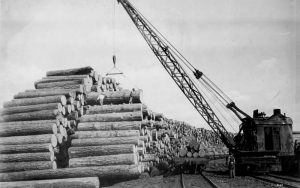
Note. From Forest History Society, 1925. CC BY- NC 2.0.
Further Reading: Crane Technology at Bulk Terminals
There are various types of cranes used at bulk ship terminals. Different types are based on their location and functionality: “bulk handing cranes can be positioned along the quay (quay crane), on a platform/pontoon (floating crane), or on the ship (deck crane)” (Notteboom, Pallis, & Rodrigue, 2021, para. 1).
Forklifts
Forklifts are used to load and unload trailers, move loads within the warehouse, move products, and skids in warehouses. Forklift trucks are rugged, can lift heavy and awkward objects to a wide range of heights and are very maneuverable. Specific licenses and certain are usually required to operate forklift trucks. They also have forks that fit into the skids used to hold products.
Figure 5.14 shows a forklift truck with its forks extended underneath the load. In this case, a picnic table has been picked up to be moved.
Figure 5.15 shows a diagram labelling the various parts of a standard forklift truck.
Figure 5.14
Forklift
Note. From Sproule, 2006. CC BY 2.0.
Figure 5.15
Note. From Tynt22, 2006. CC BY-SA 3.0 Unported license.
Smaller Equipment
Other types of Material Handling Equipment (MHE) such as hand pallets trucks, rider pallet movers, reach trucks order pickers, and narrow aisle turret trucks may be used to move products in a warehouse.
Figure 5.16 shows a smaller, manual version of a forklift called a hand pallet truck or cart. It can slide underneath a skid, in this case, boxes of fruit, and be pumped up off the ground so that one person can move inventory in a warehouse. They are easy to use and very maneuverable which saves a lot of energy and effort that would be required to move them manually.
Figure 5.16
Versatile Manual Forklifts
Note. From Toyota Material Handling EU, 2011. CC BY-NC-ND 2.0.
Figure 5.17 shows a warehouse worker moving storage bins used to house products. For many products, at some point in the process, products are moved manually.
Figure 5.17
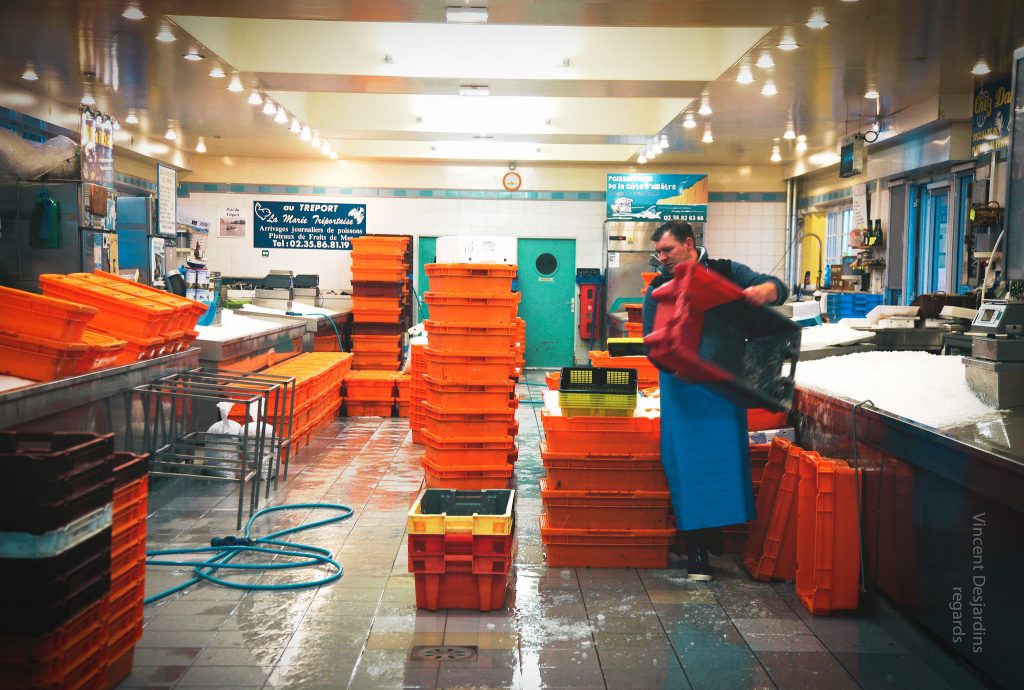 Note. From Desjardines, 2012. CC BY 2.0.
Note. From Desjardines, 2012. CC BY 2.0.
5.9 Auditing and Checking Inventory
A warehouse audit can be defined as “a general term that applies to thoroughly assess and monitoring any operation in a warehouse. Some of these audits include inventory, policies, and procedures” (APS Fulfillment, 2020, para .1). The inventory in warehouses is checked for accuracy against documentation created about that inventory. This can be done in a variety of ways, including complete counts and cycle counts.
Complete counts of the inventory are often called wall-to-wall inventory checks. This is done when a warehouse is shut down from shipping and receiving. Another method is to cycle count. With this method, smaller subsets of the inventory are periodically checked by auditing samples rather than entirely counting every product. Products are assigned audit or cycle-counting frequencies depending on their value, importance, and volumes used.
These audits and inventory checks are done to verify what your actual inventory is. Discrepancies can happen. Discrepancies between what is counted to what the documentation shows are investigated and resolved. Inventory can get lost, stolen, wrongly moved, sent to the wrong place, mislabeled, or hidden. This can lead to stock-outs (running out of stock) or too much stock resulting in extra costs.
5.10 Post Assessment (Check Your Understanding)
5.11 Note from the Author
Figure 5.18 shows a failure in packaging and handling. What has happened to the product in this box? Is it still intact and safe? The goal of successful warehouse storage focuses on safely storing and handling products so that all of it is accounted for and it can leave for its next destination safely.
Your work and time spent designing and planning for the safe storage of your products as they travel to their destination can be wasted if the product gets damaged or lost on the way or while it is stored. You are already a warehouse manager: your refrigerator at home is a small warehouse where you fill it with food, retrieve and use food and maintain safe storage of your food
Figure 5.18
Failure in Package Delivery
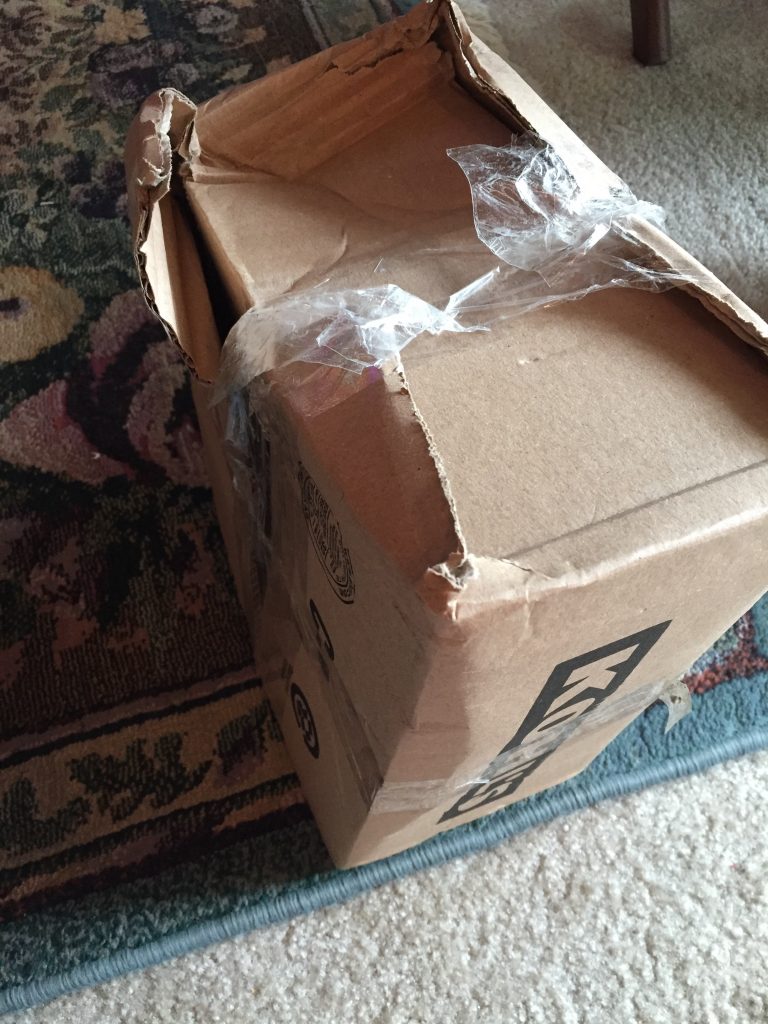 Note. From Forsaken Fotos, 2016. CC BY 2.0.
Note. From Forsaken Fotos, 2016. CC BY 2.0.
5.12 Summary
In this chapter, we have considered the role that warehousing/storage contributes to the supply chain process. We have discussed the uses of different types of warehouses, examined the role of warehouses and distribution centers in a supply chain, and described common types of equipment used to load and unload products at warehouses. The type of warehouse used plays an important role in an efficient supply chain.
5.13 Chapter References
Adams. (May 15, 2015). Renault 380 car carrier. [Photograph]. Flickr. https://www.flickr.com/photos/satransport/17688579282. Licensed for reuse under CC BY-SA 2.0.
Amazon FC Tours. (2021, April 10). Amazon Fulfillment Center Video Tour. YouTube. https://youtu.be/UAKPoAn2cB0
APICS Coach (2017, November) Break bulk warehouse. APICS Coach. https://apicsdotcoach.wordpress.com/2017/11/12/break-bulk-warehouse/
Cole International. (2016, September 21). Consolidation and cross-docking: Two methods for improving shipping efficiency. Cole Blog – Cole International. https://blog.coleintl.com/blog/consolidation-and-cross-docking
DatalogicAccuSort [username]. (2013, February 7). Cross-docking: Receiving dock direct to shipping dock [Video]. YouTube. https://youtu.be/OS5CrureJoE
Desjardines, V. (2012, April 5). France : Normandie, Seine-Maritime (76), Le Tréport : poissonnerie municipale, 7h43 [Photograph]. Flickr. https://www.flickr.com/photos/endymion120/6974239386/in/photolist-edNUUn-9DiJK9-f7h28E-9JEzQg-d6RAR1-5eMUPZ-7MGPiB-7EATqz-BbTo6v-gnhiQp-bgKdep-KwD9Mb-a6Dp1W-CUquZM-9yNhdc-cyAdz9-9K1WsV-d36iZY-DgoFWJ-6chCJJ-cFsT5y-edUApA-f7h5ob-BheMZh-sxdNLa-9Cnmvp-5j9w7a-9RvMch-abCnxX-BhpnpW-8Qwc9f-NczRMF-sfbQgu-pew1Sf-p5wiZ-9qhrGJ-hFTdVG-xHMvjq-9o62Zm-asyf8y-bChNoE-74Xvok-ndLdCJ-9rsjNn-CEwHDj-owqC77-7L4i69-9aT8AT-6C15Q4-JDxf1Q. Cropped. Adapted for reuse under CC BY 2.0.
Forest History Society. (1925). Crane loading large logs onto railroad. [Photograph]. Flickr. https://www.flickr.com/photos/foresthistory/4926794351. CC BY- NC 2.0.
Forsaken Fotos. (2016). UPS delivery epic fail. [Photograph]. Flickr. https://www.flickr.com/photos/55229469@N07/29489605404. Licensed for reuse under CC BY 2.0.
Ian BC North. (2006). Trucks at Huckleberry mine. [Photograph]. Flickr. https://www.flickr.com/photos/91997797@N00/329792944/in/photolist-v9gXf-TSgYE7-MteLXk-7k7DiU-wnkr5-VjUnSX-NbbsB5-5yeCPH-T8wXkh-95h31u-5yj1UE-9LJY37-5vUGRc-8ksE6t-kJ5Fvq-65SjPv-Dpmjr8-pNb8w-7Uh6Hp-PSd5YS-6Z8JcB-GVzqEk-kVzH8P-2VrdjR-9jaWwc-dMnddX-Ha2GX5-ohThsg-9Tui74-gWAr8Q-P7TPrq-zjDeWk-i5fR7-9LGHxt-AHf7n3-adKiH4-9LKbdu-7Uksmb-azMsXn-2brB1QN-26X9cCj-cYy2Jb-cYya4J-9LKwk1-cvA57h-AUGm3g-746EMr-eyjfDH-JfzJga-9LGy1e. Licensed for reuse under CC BY-NC 2.0.
Jaxport. (2013). First shipment of Volkswagens arrive at Blount Island. [Photograph]. Flickr. https://www.flickr.com/photos/jaxport/17104977627/in/photolist-s4vtVn-GoxtWT-rqQnNd-pTeZ7K-8RMn6S-wjwpKS-rr2EDK-s6odxH-ioei3X-NcowZe-iodzw2-iodAYF-t2ty9g-416Ez1-Uours4-pE6mrX-rksGFE-efpcj4-8RJf9e-efpdX4-8RMmHo-8RJfdz-g4Z8sZ-2a1LPz6-7YYT8y-pAUPRE-8RJf6v-8RMnkh-416HYj-CpJyyA-L6eeo7-ajvLfY-416PA9-LcCFiA-ajvKQh-p8V22-hF5uT4-a49aKi-28opnAw-7YYnQ3-2joYoPc-2m93g9b-2m8X42X-xuhJT-2md8VAu-2mtGc8Q-2iN5qpp-2kZWsPZ-2kZZkyw-5DeXwG. Licensed for reuse under CC BY-NS 2.0.
Jaxport. (2013). Talleyrand terminal railroad. [Photograph]. Flickr. https://www.flickr.com/photos/jaxport/8634966179. Licensed for reuse under CC BY-NC 2.0.
Kramer. (2009). Port of Miami, Container Ship Yard. [Photograph]. Wikimedia Commons. https://commons.wikimedia.org/wiki/File:Port_of_Miami_container_ship_yard.jpg. Licensed for reuse under CC BY 2.0.
Lang. (2015). Used Car Dealership. [Photograph]. Wikimedia Commons. https://commons.wikimedia.org/wiki/File:Car_Dealer.jpg. Licensed for reuse under CC BY-SA 4.0.
Lester Public Library. (2012). First Floor Cutting Room. [Photograph]. Flickr. https://www.flickr.com/photos/lesterpubliclibrary/7985523567/in/photolist-daDTWP-7FQ3d2-6eC6AD-6eGeiu-d7uj4L-dma4VS-82H8x2-82LeZ3-94mNBY-wFrYrx-pZ5AwJ-94mMtJ-dma5zo-7MjCaA-eGKsy-9Zfuow-daEsp7-94mMxN-9diGTp-g4thPJ-dma2d8-82GYqT-9U2veX-2kxrb4J-2fXUbhK-ZMnGe3-qNGAGn-SqBxKs-2iZqv3x-2hUj1RM-2iRM5rd-2iZqqaS-CimJBq-23q7Jcv-2j6hukV-BUqfv2-2j39yF7-2j6fYva-2iZuMQ6-2i2hfXd-2hUj1Hf-2i5s488-2hHFcNA-2i8PWJK-2iZt6Q7-2j6dkbg-2iZHABT-oJ6tU4-2hUj1Fb-2hLkCbb. Licensed for reuse under CC BY-NC-SA 2.0.
McKibben, K. (2017, February 3). What is cross-docking? [Video]. YouTube. https://youtu.be/N2lnL9uHyNY
Millennium Luxury Coaches. (2010). Parts room. [Photograph]. Flickr. https://www.flickr.com/photos/millenniumluxurycoaches/5288861748/in/p. Licensed for reuse under CC BY-NC-SA 2.0.
Notteboom, T., Pallis, A. & Rodrigue, J.P. (2021). Crane technology and bulk terminals. Port Economics, Management and Policy. https://porteconomicsmanagement.org/pemp/contents/part3/bulk-breakbulk-terminal-design-equipment/crane-technology-at-bulk-terminals/
Phil’s. (2011). Pony Delivery- Canyon Park Ford. [Photograph]. Flickr. https://www.flickr.com/photos/1stpix_diecast_dioramas/6519504529. Licensed for reuse under CC BY-NC-SA 2.0.
Rodrigue, J.P. (2021). Point-to-point versus hub-and-spoke networks. The Geography of Transport Systems. https://transportgeography.org/contents/chapter2/geography-of-transportation-networks/point-to-point-versus-hub-and-spoke-network/
Sproule, R. (2006, September 1). Forklift [Photograph]. Flickr. https://www.flickr.com/photos/robbie1/238070488/in/photolist-n3b4A-6V9XCy-6V9Xt9-6V9Xfw-o79s8-o79rz-o79rn. Licensed for reuse under CC BY 2.0.
Sunol, H. (2021, March 14). Consolidation warehouse – Its meaning, benefits, and drawbacks. Cyzerg Warehouse Technology. https://articles.cyzerg.com/consolidation-warehouse-meaning-benefits-and-drawbacks
Toyota Material Handling EU. (2011). BT Lifter Hand Pallet Trucks. [Photograph]. Flickr. https://www.flickr.com/photos/toyotamheurope/6323175476. Licensed for reuse under CC BY-NC-ND 2.0.
Tynt22. (2006, July 8). Forklift [computer-generated diagram]. Wikimedia Commons. https://commons.wikimedia.org/wiki/File:Forklift_Truck.jpg. Licensed for reuse under CC BY-SA 3.0.
5.14 Image Descriptions
Figure 5.1 This figure shows a generic product supply chain flowchart: Raw materials selection then logistics (movement and storage, warehouses and bulk storage), then manufacture stage, then logistics (movement and storage, distribution centres and warehouses), to retail stores and/or consumers, then to product end use. [Back to Figure]
Figure 5.3: This figure shows different types of warehouses at different points in the supply chain. From left to right, there is before logistics, logistics and after logistics.
-
- Before Logistics
- Origin = Extract Raw materials OR manufacture a product
- Warehouse at the Supplier:
- Finished Goods Storage
- Raw Material Piles
- Logistics =
- En Route = move and store materials or products
- Warehouses In-transit:
- Consolidation
- cross-docking
- break-bulk
- hub and spoke
- distribution centers
- Outside storage areas and storage yards might also be used.
- After Logistics
Destination = Customer [Back to Figure]
- Before Logistics
Figure 5.6: This figure shows a cross-docking warehouse. From left to right, there is suppliers bring products to the cross-docking terminal where it is moved to customer trucks to be transported to customers
-
- Suppliers
- Parts from Company A
- Parts from Company B
- Parts from Company C
- Cross-Docking Terminal
- Customers
- Truck with parts from Company A, B and C
- To Customer #1
- Truck with parts from Company A, B and C
- To Customer #2
- Truck with parts from Company A, B and C
- To Customer #3 [Back to Figure]
- Customers
- Suppliers

